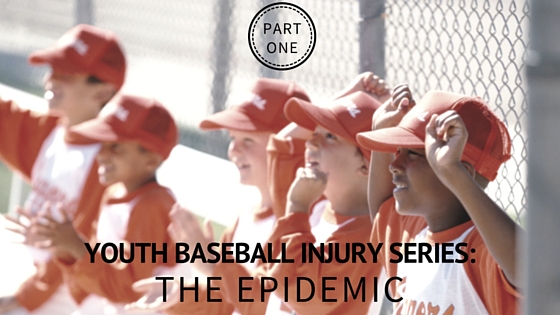Youth Baseball Injury Series, Part I: The Epidemic
Jun 1 In the past few years, a great deal of attention has been paid to the increasing number of arm injuries to professional baseball pitchers. In reality, arm injuries have been on the rise since the early 2000s and reached epidemic proportions.
In the past few years, a great deal of attention has been paid to the increasing number of arm injuries to professional baseball pitchers. In reality, arm injuries have been on the rise since the early 2000s and reached epidemic proportions.
Research suggests a seven- to 10-fold increase in youth pitching injuries since 2010, with the elbow taking the biggest hit. Among youth baseball players ages 9-12, an estimated 26 percent of players report elbow pain.
Common reported injuries include tendinitis, apophysitis (growth plate inflammation), fractures, cartilage damage, and ligament tears.
Elbow ligament reconstruction surgery, nicknamed the “Tommy John” procedure, gets the most press because of its prevalence in Major League Baseball. But it has grown in popularity among youth, too: from 1994-1997, only 7 percent of Tommy John surgeries were performed on youth and high school players; from 2007-2011, 57 percent of surgeries were performed on 15- to 19-year-olds.
How did we get here?
The youth sports landscape has changed in the past 15 years, and baseball is no exception. Some would say that baseball has even led the way. We live in the age of early specialization in which kids often play only one sport, year-round. They get little time off and miss out on the cross-training benefits associated with kids who play multiple sports.
The economics behind youth sports also is at play here. Baseball complexes can make significant amounts of money by hosting tournaments every weekend. Baseball academies field dozens of travel teams that bring in thousands of dollars in revenue.
These competitive travel teams can cram more than 50 games into a year. That is similar in number to what college teams play in their entire spring seasons. The difference is the college athletes have dedicated pitching staffs, in- and off-season strength and conditioning programs, and access to athletic training staffs to keep them healthy.
There also is growing pressure on young athletes to stand out in order to earn scholarships. Radar guns are a common sight at tournaments, where “lighting up the gun” with high numbers garners attention.
Showcases are more prevalent, too. Groups of scouts or college coaches will invite potential prospects/recruits to come to a location and max out for a very short time. These showcases often occur during the already hectic summer season.
High-risk behaviors:
- Pitching while fatigued (36 times more likely to be injured)
- Pitching competitively for more than eight months per year (five times more likely to be injured)
- Pitching on consecutive days
- Pitching on multiple teams
- Pitching multiple games on the same day
- Throwing mechanic flaws
- Ignoring established pitch count recommendations
Injury symptoms can vary greatly, but some of the most common are:
- Pain or tightness while throwing
- Tightness or loss of range of motion after throwing
- Soreness that lasts for several days after pitching
- Loss of velocity or control of pitches
- Swelling in forearm, elbow, or shoulder
- Numbness in forearm or hand (particularly ring and pinky fingers)
If your son or daughter has any of these symptoms, you should seek out a healthcare professional in your area for an evaluation.
Click here to read Part II of the Series on Reducing Injuries in Youth Baseball.
